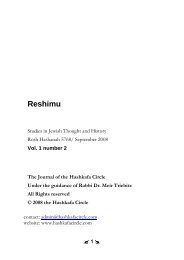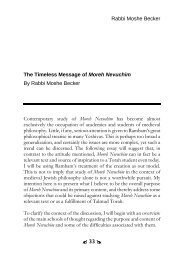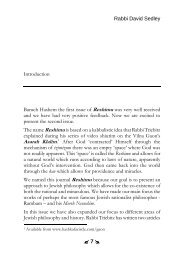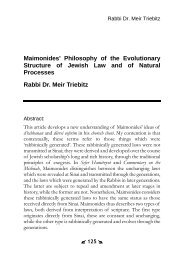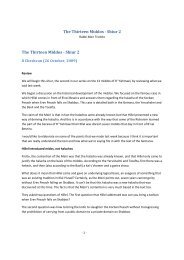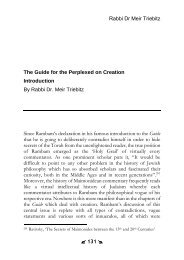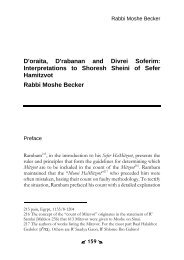Rambam's Theory of Divine Attributes - Hashkafa Circle
Rambam's Theory of Divine Attributes - Hashkafa Circle
Rambam's Theory of Divine Attributes - Hashkafa Circle
Create successful ePaper yourself
Turn your PDF publications into a flip-book with our unique Google optimized e-Paper software.
Rabbi Meir Triebitz<br />
Rambam’s <strong>Theory</strong> <strong>of</strong> <strong>Divine</strong> <strong>Attributes</strong><br />
By Rabbi Meir Triebitz<br />
I. The Problem<br />
The First Division <strong>of</strong> Rambam’s Guide for the Perplexed culminates in a<br />
treatise spanning twenty chapters (I.§50-69) which, taken together,<br />
set forth the negative theology that will underpin his famous attack<br />
against Kalam philosophy concluding that First Division. In that<br />
treatise Rambam makes his equally famous radical claim that the<br />
Jewish commandment <strong>of</strong> <strong>Divine</strong> unity (and incorporeality) forbids<br />
any positive description <strong>of</strong> God whatsoever; God can be described<br />
by no positive statement <strong>of</strong> any kind. And with this radical assertion<br />
Rambam seeks explicitly to reject not only the Christian notion <strong>of</strong> the<br />
Trinity but with it the contemporary Islamic ‘theory <strong>of</strong> attributes’<br />
expounded by the Muslim Kalam. While the intention <strong>of</strong> the latter is<br />
to propose a notion <strong>of</strong> <strong>Divine</strong> attribution reconcilable with their strict<br />
monotheism, in contradistinction to what was for them the clearly<br />
paganistic doctrine <strong>of</strong> the Christian Trinity, Rambam nevertheless<br />
denies any such distinction and rejects both theories on the same<br />
grounds. “[T]rue Oneness” consists in rejecting any possible<br />
73
Rambam’s <strong>Theory</strong> <strong>of</strong> <strong>Divine</strong> <strong>Attributes</strong><br />
“composition whatever […] to be found in Him” and any “possibility<br />
<strong>of</strong> division in any way whatever,” so that attribution upon Him<br />
would be tantamount to corporeality: “[J]ust as it is impossible that<br />
He should be a body, it is also impossible that He should possess an<br />
‘essential attribute’” (I.§50; Munk 57a / Pines 111). 1 Attribution is, in<br />
short, in His case always our error.<br />
Such a principle is plain enough. But so too are the grounds for its<br />
continual violation. For since language does not always serve<br />
faithfully to represent religious doctrine, but rather allows us to<br />
“hold[…] beliefs to which […] [we] do not attach any meaning<br />
whatever,” we are ever liable to fall into the folly <strong>of</strong> drawing false<br />
distinctions not correspondent with any underlying true beliefs, “as if<br />
we aimed at and investigated what we should say and not what we<br />
should believe” (ibid. 56b-57a), as when the fool seeks only to mouth<br />
correct beliefs without genuine knowledge <strong>of</strong> what is spoken about.<br />
Thus “[i]f […] someone believes that [God] is one, but possesses a<br />
certain number <strong>of</strong> essential attributes, he says in his words that He is<br />
one, but believes Him in his thought to be many.” This indeed is the<br />
error <strong>of</strong> the Kalam philosophers, who while motivated to distinguish<br />
their own thought from Christian theology, wander onto the path <strong>of</strong><br />
the very error they seek to repudiate, that error being “what the<br />
Christians say: namely, that He is one but also three, and that the<br />
three are one.” God’s Unity properly understood obviates any theory<br />
<strong>of</strong> attributes, including that proposed by the Islamic philosophers,<br />
whose would-be improvement over the Christian Trinity is only<br />
cosmetic: an alteration <strong>of</strong> theological language but not <strong>of</strong> underlying<br />
theological doctrine.<br />
1 All translations herein unless otherwise noted are those <strong>of</strong> Shlomo Pines (Ed. and<br />
trans., Guide <strong>of</strong> the Perplexed; Chicago: U <strong>of</strong> Chicago P, 1963). Citations are, first, to<br />
Book and Section number (which are the Rambam’s own), followed by the folio<br />
leaf and side <strong>of</strong> S. Munk’s Arabic manuscript (Paris, 1856-66) as notated in Pines’s<br />
edition, followed last by Pines’s own English pagination.<br />
74
Rabbi Meir Triebitz<br />
The bulk <strong>of</strong> this twenty-chapter treatise (specifically, its first eighteen,<br />
§50-67) leaves the reader with an elaborated demonstration why it is<br />
impossible to assign any positive attribute to God, why all what may<br />
be legitimately described <strong>of</strong> God is either what He is not, or—and<br />
this is crucial 2 —in what some act <strong>of</strong> His consists. Only via such<br />
descriptions do we describe merely the creation or some aspect <strong>of</strong> it<br />
without overstepping ourselves and pretending to describe the<br />
Creator Himself—the latter amounting, <strong>of</strong> course, to (false)<br />
attribution, which in the case <strong>of</strong> God has been categorically ruled out.<br />
So it comes as something <strong>of</strong> a shock when, in the final two chapters<br />
(§68-69), Rambam explicitly describes God’s essence with attributes,<br />
specifically by attributing to Him intellect, will and wisdom, and life.<br />
Concerning the first <strong>of</strong> these, Rambam defines “the intellect which<br />
is His essence” as “[t]he act <strong>of</strong> apprehension owing to which He is<br />
said to be an intellectually cognizing subject” (§68, 87b/165;<br />
emphasis added). So it would seem that God thinks (an act) because<br />
He has an intellect (an attribute). Concerning the second two, namely<br />
“His will and wisdom,” which, again, “are identical with His<br />
essence,” to them attributes Rambam “the order <strong>of</strong> all ends” (§69,<br />
90b/170; emphasis added):<br />
[…]He […] is the ultimate end <strong>of</strong> everything[…]. This […] is<br />
the meaning <strong>of</strong> His will, which is His essence. In virtue <strong>of</strong><br />
this it is said <strong>of</strong> Him that He is the end <strong>of</strong> all ends[…]. For<br />
this reason the philosophers designated Him as a cause and<br />
not only as a maker.<br />
Attribution to God (now as causatively relating to the world) is, in<br />
other words, justified from some essential feature <strong>of</strong> God Himself<br />
(that He wills). And this superposition <strong>of</strong> worldly attributes onto the<br />
2 For more on the nuances <strong>of</strong> the Rambam’s negative theology as well as its relation<br />
to prophecy, the reader is referred to this author’s “Rambam’s <strong>Theory</strong> <strong>of</strong> Negative<br />
Theology: <strong>Divine</strong> Creation and Human Interpretation” in the inaugural issue <strong>of</strong><br />
these pages (v1:1, March 2008: 9-28).<br />
75
Rambam’s <strong>Theory</strong> <strong>of</strong> <strong>Divine</strong> <strong>Attributes</strong><br />
<strong>Divine</strong> Essence is pushed still further when, immediately preceding<br />
(ibid. 90a/169), we call Him ‘alive’:<br />
God has […] with reference to the world, the status <strong>of</strong> a<br />
form with regard to a thing possessing a form, in virtue <strong>of</strong><br />
which it is that which it is: a thing the true reality and essence<br />
<strong>of</strong> which are established by that form[…]. Because <strong>of</strong> this<br />
notion, God is called in our language the ‘Living <strong>of</strong> the<br />
worlds’ meaning that He is the life <strong>of</strong> the world, as shall be<br />
made clear.<br />
It seems that the prospect <strong>of</strong> describing God’s life sends us directly<br />
into the realm <strong>of</strong> positive analogy with the world, if not into<br />
expressed positive description as worldly. One has to wonder what<br />
relevance or sense remains to the crucial point <strong>of</strong> Rambam’s first<br />
eighteen chapters forbidding any divine attribution by the time we<br />
have, in the final two chapters, elucidated God’s very essence as<br />
thinking, living, wise, and willful, undermining, it would seem, one <strong>of</strong> the<br />
fundamental tenets and central themes <strong>of</strong> the Guide.<br />
Put briefly: Why may we, following the Rambam, attribute to God’s essence<br />
these attributes (<strong>of</strong> intellect, wisdom, will, and life) without contraverting belief in<br />
God’s unity as demanded by the Torah? Which is to ask: How does Rambam<br />
mean to escape his own charges against the Islamic philosophers that have fallen<br />
prey to meaningless linguistic dogma at the expense <strong>of</strong> rationally founded belief?<br />
Or still, put most generally: How can the theology <strong>of</strong> the Guide hope to<br />
collapse the Muslim Kalamist project into the failures <strong>of</strong> Christian theology while<br />
itself remaining philosophically distinct <strong>of</strong> that project?<br />
II. A Rejected Answer: Rav Saadiah on the Christian<br />
Trinity<br />
The theory <strong>of</strong> attributes was a relatively late development in Islamic<br />
thought. According to some 3 it was probably imported as a<br />
3 See, for example, H. A. Wolfson, ”The Muslim <strong>Attributes</strong> and the Christian<br />
Trinity,” Harvard Theological Review, v49/n1 (January 1956): 1-18.<br />
76
Rabbi Meir Triebitz<br />
consequence <strong>of</strong> Christian-Muslim dialogue, wherein even the<br />
staunchest Islamic apologists defending against any Trinitarian<br />
conceptions were forced to concede that the Creator must necessarily<br />
possess some certain attributes, such as wisdom, power, or<br />
knowledge, even while His incorporeality precludes any independent<br />
description <strong>of</strong> His essence without undermining His unity. A<br />
stalwart monotheist is thus forced to the conclusion that God’s<br />
essence is identical with His wisdom, His life, and His power and thus<br />
too to the concession that God is properly describable by essential<br />
attributes we may understand as properly his own such as these—i.e.,<br />
not attributes that He has but attributes He Himself Is. Indeed, it is<br />
precisely in contradistinction to Christian theological error that Rav<br />
Saadiah Gaon, in his Book <strong>of</strong> Beliefs and Opinions, enunciates this<br />
conclusion two and a half centuries prior to the Rambam’s Guide:<br />
[L]et me say that […] the Christians erred when they assumed<br />
the existence <strong>of</strong> distinction in God’s personality which led<br />
them to make <strong>of</strong> Him a Trinity and to deviate from the<br />
orthodox belief […]. [They] maintain that they adopted their<br />
belief in the Trinity as a result <strong>of</strong> rational speculation and<br />
subtle understanding and that it was thus that they arrived at<br />
these three attributes and adhered to them. Declaring that<br />
only a thing that is living and omniscient is capable <strong>of</strong><br />
creating, they recognized God’s vitality and omniscience as<br />
two things distinct from His essence, with the result that<br />
these became for them the Trinity. 4<br />
The argument for a ‘theory <strong>of</strong> attributes’ is very compelling: If one<br />
admits that God can be described as ‘living,’ ‘knowing,’ or ‘willing,’<br />
why should God’s ‘life,’ ‘knowledge’ or ‘will’ be any less real than His<br />
existence? On the other hand, an attribute which is separate or other<br />
from Himself would necessitate corporeality or some disunity within<br />
4 The Book <strong>of</strong> Beliefs and Opinions [Emunot ve-Deot], trans. Rosenblatt (New Haven, CT:<br />
Yale UP, 1989): 103-104.<br />
77
Rambam’s <strong>Theory</strong> <strong>of</strong> <strong>Divine</strong> <strong>Attributes</strong><br />
Him. The only apparent solution is to posit attributes, such as those<br />
listed above, which are “at one with His existence,” i.e., essential.<br />
The distinction between this approach and that <strong>of</strong> Christianity can be<br />
explained in the following way: Christianity posits that these<br />
attributes are themselves separate personae, a viewpoint is<br />
fundamentally paganistic or polytheistic. Islam, by denoting them<br />
‘attributes’ and not separate personae, seems to do away with the<br />
objection <strong>of</strong> paganism. Rav Saadiah counters, however, that so long<br />
as “one attribute is not identical with the other,” God necessarily<br />
becomes corporeal. Thus, the only way to understand the matter is to<br />
maintain that all His attributes are in fact one, however indescribable<br />
may be that essential unity. We maintain them as one, even as in<br />
speech we multiply them, just as the fire-worshipper “who says that<br />
he does not worship the fire but the thing that burns and gives light<br />
and rises upward, which is in reality nothing else than fire.”<br />
Rav Saadiah’s argument against this Islamic view, however, is that so<br />
long as “one attribute is not identical with the other,” God<br />
necessarily becomes a corporeal being. He claims that the only way to<br />
understand the matter is to maintain that all these attributes are in<br />
fact one. It is possible to think <strong>of</strong> them as one, even though it is<br />
impossible for a human being to combine these attributes as one in<br />
speech. Yet this does not pose a serious problem. Rav Saadiah cites<br />
an analogy <strong>of</strong> “him who says that he does not worship the fire but<br />
the thing that burns and gives light and rises upward, which is in<br />
reality nothing else than fire”.<br />
It is clear that Rambam did not find Rav Saadiah’s theological<br />
rejoinder compelling. While in the chapters that concern us here—<br />
those final, problematic chapters cited above (§68-69)—Rambam<br />
identifies God’s essence with His will, His existence, His life, and His<br />
wisdom, there is no attempt to unite and identify those four<br />
attributes. On the contrary, the attributes <strong>of</strong> will and wisdom are<br />
explicated in worldly terms; their being given worldly meaning<br />
undermines such a notion <strong>of</strong> implicit unity as Rav Saadiah would<br />
78
Rabbi Meir Triebitz<br />
want to suggest. In the final analysis, it would appear that not only is<br />
Rambam advocating a theory <strong>of</strong> attributes that directly contradicts his<br />
own theology as laid forth in the prior chapters (Guide §50-67) but<br />
also a theory that contravenes the defense <strong>of</strong> such a theory Rav<br />
Saadiah could <strong>of</strong>fer. The need for a resolution thus becomes more<br />
pressing, as it would seem that Rambam is indeed putting forth a<br />
theory <strong>of</strong> attributes in the very tradition <strong>of</strong> those Islamic thinkers he<br />
manifestly would want to condemn as re-cosmeticized Christians.<br />
Our aforementioned contradiction stands, and stands indeed against<br />
an even wider opposition than we initially supposed.<br />
III. A Resolution<br />
Contradictions in the Guide should not be dismissed as mere lapses<br />
by the author. On the contrary, they are Rambam’s vehicle for<br />
teaching to his more astute and intelligent readership. This, in fact, is<br />
his primary addressee, as he declares plainly at the outset <strong>of</strong> his work:<br />
“I am he who prefers to address that single [virtuous] man by<br />
himself,” to which end he will readily sacrifice contenting an audience<br />
<strong>of</strong> “ten thousand ignoramuses” (I. Introduction, 9b/16). In a famous<br />
passage <strong>of</strong> that Introduction Rambam very explicitly maintains that<br />
contradictions the reader finds in the Guide exist to a purpose and are<br />
<strong>of</strong> two types (11b/20): Either they arise “from the necessity <strong>of</strong><br />
teaching and making someone understand” an “obscure matter that<br />
is difficult to conceive”—in which case the explanation that “is easy<br />
to conceive” will precede the more difficult, more exacting<br />
explanation, laying forth “that obscure matter […] in exact terms and<br />
explain[ing] as it truly is” (10a/17-18)—or, alternatively, arise “in<br />
speaking about very obscure matters,” so obscure that the speaker<br />
need “conceal some parts and […] disclose others” (10b/18;<br />
emphasis added):<br />
Sometimes in the case <strong>of</strong> certain dicta this necessity requires<br />
that the discussion proceed on the basis <strong>of</strong> a certain premise,<br />
79
Rambam’s <strong>Theory</strong> <strong>of</strong> <strong>Divine</strong> <strong>Attributes</strong><br />
whereas in another place necessity requires that the<br />
discussion proceed on the basis <strong>of</strong> another premise<br />
contradicting the first one. In such cases the vulgar must<br />
in no way be aware <strong>of</strong> the contradiction; the author<br />
accordingly uses some device to conceal it by all means.<br />
Put very briefly: The first contradiction occurs as a kind <strong>of</strong> stepwise<br />
pedagogical tool, while the second seeks surreptitiously to teach to a<br />
heterogeneous audience <strong>of</strong> mavens and novices, the sophisticate and<br />
the vulgar.<br />
I want to assert that our contradiction here regarding negative<br />
theology is <strong>of</strong> the second type. 5 Rambam’s exposition <strong>of</strong> negative<br />
theology is too difficult and involved for us to assume that he is just<br />
making the matter “easy to conceive” in the manner <strong>of</strong> the first type<br />
<strong>of</strong> contradiction. In all likelihood Rambam was <strong>of</strong> the opinion that<br />
his negative theology was too subtle for most readers, and the<br />
contradiction by which he here elucidates it reflects a tension both<br />
essential and essentially irresolvable: Although the prohibition against<br />
paganism requires foremost that we forgo any positive attributes for<br />
God and thereby avoid anthropomorphism, we nonetheless need<br />
ways <strong>of</strong> speaking about God and about His acts—indeed, about such<br />
things as “His Wisdom and Will” (quoted above)—and that we be<br />
able to do so in ways we can relate to—that is to say,<br />
anthropomorphically. As a result, an authentic Jewish theology must<br />
validate this ever irresolvable, ever relevant tension, at once<br />
irreducible and dichotomous, by walking a course that averts us from<br />
paganism on one hand while on the other providing us a way we can<br />
speak about and relate to God—a course, in short, between<br />
polytheism and atheism. Such a theology requires, almost as its<br />
5 “First” and “second” are termed here for our purposes only. In the Rambam’s<br />
Introduction they actually correspond, respectively, to the fifth and seventh <strong>of</strong> the<br />
types <strong>of</strong> contradiction listed there.<br />
80
Rabbi Meir Triebitz<br />
natural literary device, paradox and contradiction to elucidate this<br />
dialectical tension.<br />
This method <strong>of</strong> exposition by paradox is evidenced most elegantly in<br />
Rambam’s interpretation <strong>of</strong> the dialogue between Moshe and God<br />
(Shemos 33), the underlying subject <strong>of</strong> which is according to him<br />
most fittingly the fundamental principles <strong>of</strong> Jewish negative theology<br />
(Guide 64b/124). Moshe entreats two requests <strong>of</strong> God: “Show me<br />
now Your ways, that I may know You…” (v13) and “Show me, I<br />
pray You, Your Glory” (v18). Initially God does not respond to the<br />
first but only later concedes after categorically denying Moshe the<br />
second: “You cannot see My face” (v20), but “I will make all My<br />
Goodness pass before You” (v19). The initial reticence followed by<br />
later acquiescence expresses the potential danger <strong>of</strong> the first request,<br />
and only by being denied the second is Moshe granted it. It is as if to<br />
suggest that both requests—or, we’ll suggest, both questions—are really<br />
forbidden—or, to say the same here, unanswerable—but that for lack<br />
<strong>of</strong> any clear alternative and out <strong>of</strong> necessity, we receive a grant <strong>of</strong> the<br />
lesser only once we have been explicitly barred from the greater, that<br />
we may thereby come to recognize the essential impossibility <strong>of</strong><br />
either request being granted—and the a priori provisionality <strong>of</strong> any<br />
such answer to either question. Man’s relationship to God is<br />
illustrated by two questions, where the one answer can only come at all<br />
upon the complete forsaking <strong>of</strong> the other. Within the Biblical<br />
dialogue between God and Moshe resides a fundamental paradox<br />
illustrative <strong>of</strong> and explicated by the dichotomy <strong>of</strong> Rambam’s negative<br />
theology: Man may predicate certain attributes to God only once<br />
such predication has been already set apart from ordinary predication<br />
as always ultimately in vain.<br />
This method <strong>of</strong> exposition by paradox is not confined to the nuances<br />
<strong>of</strong> negative theology; we see it arising again throughout the Guide.<br />
Perhaps the most notable example is the difficulty <strong>of</strong> reconciling the<br />
Torah presumption <strong>of</strong> an incorporeal Creator ex nihilo with His<br />
81
Rambam’s <strong>Theory</strong> <strong>of</strong> <strong>Divine</strong> <strong>Attributes</strong><br />
eternity. 6 As a consequence, while Rambam’s discussion <strong>of</strong> creation<br />
begins by asserting that the opinion <strong>of</strong> Torat Moshe is that the world<br />
was created by God ex nihilo, by the time that discussion concludes<br />
eighteen chapters later (II.§30), 7 he makes the subtle point, casually<br />
dropped as if merely incidental, that one <strong>of</strong> the terms referring to<br />
creation in the Torah (qinyan, qeil qoneh) itself “tends toward the road<br />
<strong>of</strong> the belief in […] eternity” (71b/358). To the astute ear honed to<br />
his method <strong>of</strong> paradoxical exposition, the underlying thrust is clear:<br />
He begins with the assertion he believes to be obvious and most<br />
fundamental—namely, creatio ex nihilo—after which, following long<br />
diversions, he introduces the contrary premise—creatio continua<br />
aeterna—by which time the less aware, less initiated reader will likely<br />
not notice the subtle discrepancy and the controversial nuance<br />
therein entailed: that creation ex nihilo is not creation in time, chiddush<br />
nifla.<br />
And so it is in the case at hand. That the Torah rejects any theory <strong>of</strong><br />
attributes is a premise most obvious and fundamental, subsumed<br />
within the repudiation <strong>of</strong> paganism upon which Torat Moshe is<br />
founded and against which it even defines itself. After a long<br />
discussion which emphasizes and reemphasizes this point, thereby<br />
wearing out all but Rambam’s most alert reader, only then can he<br />
bring up a contrary premise for his selected and intended audience,<br />
that he might convey to them a more nuanced theology involving<br />
conceptions, e.g., <strong>of</strong> divine will, divine wisdom, and divine life.<br />
6 For an extended examination <strong>of</strong> this contradiction in the Guide and its relation to<br />
prophecy and intellectual self-perfection, the reader is referred to this author’s<br />
“Rambam’s <strong>Theory</strong> <strong>of</strong> Negative Theology: <strong>Divine</strong> Creation and Human<br />
Interpretation” (Op. cit. above n.2).<br />
7 For an extended examination <strong>of</strong> this contradiction in the Guide and its relation to<br />
prophecy and intellectually self-perfection, the reader is referred to this author’s<br />
“Rambam’s <strong>Theory</strong> <strong>of</strong> Negative Theology: <strong>Divine</strong> Creation and Human<br />
InterpretationGuide for the Perplexed on Creation” previously appearing in these<br />
pages (Reshimu v1/n2, September 2008: 131Op. cit. above n.2).<br />
82
Rabbi Meir Triebitz<br />
IV. Conclusions<br />
We have asserted thus far that Rambam’s negative theology is not as<br />
monolithic as it is radical, but rather that it rests on a fundamental<br />
dichotomy that demands a dialectical, self-contradictory exposition,<br />
and that his theology requires this dichotomy precisely in order that<br />
the nuances therein not come at the expense <strong>of</strong> the radicality <strong>of</strong> its<br />
basic premises—in other words, in order that the simple<br />
understanding <strong>of</strong> the vulgar reader not be compromised for the sake<br />
<strong>of</strong> a more nuanced but more accurate truth aimed at the lone<br />
sophisticates within Rambam’s audience. That we may allay<br />
skepticism <strong>of</strong> this assertion—which, we grant, must remain<br />
conjectural—it behoves us to examine more closely the concluding<br />
chapters <strong>of</strong> Rambam’s treatise (namely, the aforementioned Guide<br />
I.§50-69) in light <strong>of</strong> it. Therein (§68-69), so we’ve claimed, positive<br />
divine attributions ostensibly violate his initial premise <strong>of</strong> divine<br />
inattributability, among them intellect and will. It is those we shall reexamine<br />
now.<br />
Regarding God’s intellect we have from Rambam’s Mishneh Torah the<br />
fundamental “philosophers’” principle that God, being absolutely<br />
unitary, is uniquely characterized by being with regard to His act <strong>of</strong><br />
knowledge at once identically the knower, the known, and the<br />
knowing itself—in the words <strong>of</strong> the Guide, “the intellect as well as the<br />
intellectually cognizing subject and the intellectually cognized object”<br />
(§68, 86b/163). 8 Presumably this identity would not only distinguish<br />
God from man but uniquely characterize Him; indeed, in the Mishneh<br />
Torah it ostensibly serves as the culmination <strong>of</strong> the negative theology<br />
briefly summarized therein—a negative essential attribute <strong>of</strong> sorts.<br />
Yet Rambam closes the same chapter <strong>of</strong> the Guide with what is a very<br />
8 Cf. Sefer haMada’: Hilchot Yesodei haTorah 2:10<br />
83
Rambam’s <strong>Theory</strong> <strong>of</strong> <strong>Divine</strong> <strong>Attributes</strong><br />
surprising point, the more so in the context <strong>of</strong> that very chapter<br />
(88a/165-66):<br />
[T]he numerical unity <strong>of</strong> the intellect, the intellectually<br />
cognizing subject, and the intellectually cognized object does<br />
not hold good with reference to the Creator only, but also<br />
with reference to every intellect. […I]n us too, the<br />
intellectually cognizing subject, the intellect, and the<br />
intellectually cognized object are one and the same thing[…].<br />
Man and God both, it seems, intellectualize similarly; man actualizes<br />
his intellect in time, while God, Himself a purely active intellect, is<br />
always actuating what man only actuates at certain given moments.<br />
Let us be clear: Not only is Rambam concluding the chapter with an<br />
implicit contradiction, but he implicitly contradicts his “fundamental<br />
principle” by explicitly analogizing God to man, contradicting<br />
thereby his entire negative theology most blatantly. Of course,<br />
explanation is in order (ibid. 166):<br />
[…] His Essence is the intellectually cognizing subject, the<br />
intellectually cognized object, and the intellect, as is also<br />
necessarily the case with regard to every intellect in action.<br />
We have repeated this notion several times in this chapter<br />
because the minds <strong>of</strong> men are very much strangers to this<br />
way <strong>of</strong> representing the thing to oneself. I did not consider<br />
that you might confuse intellectual representation with<br />
imagination and with the reception <strong>of</strong> an image <strong>of</strong> a sense<br />
object by the imaginative faculty, as this Treatise [the Guide]<br />
has been composed only for the benefit <strong>of</strong> those who have<br />
philosophized and have acquired knowledge <strong>of</strong> what has<br />
become clear with reference to the soul and all its faculties.<br />
The last <strong>of</strong> the three sentences above, it would seem, aims at<br />
addressing the contradiction. (And given our understanding <strong>of</strong> the<br />
Rambam’s method <strong>of</strong> surreptitious instruction to the lone maven<br />
beyond the attention <strong>of</strong> the vulgar many, we should not be surprised<br />
84
Rabbi Meir Triebitz<br />
that he addresses the contradiction quite briefly and without<br />
emphasis.) The answer he <strong>of</strong>fers, however unprecedented, is itself<br />
clear enough and even intuitive:<br />
Intellect is unique among our faculties, yet such uniqueness is <strong>of</strong>ten<br />
compromised by the minds <strong>of</strong> most men (or, in this case, most<br />
readers) who are apt to analogize the intellect to one <strong>of</strong> their other<br />
mental faculties, such as imagination or sensation. With respect to<br />
acts <strong>of</strong> those more corporeal faculties, any anthropomorphic analogy<br />
applied to God will necessarily violate His incorporeality. But in the<br />
case <strong>of</strong> intellect, being essentially and uniquely incorporeal, one can<br />
describe God and man in similar ways without violating the<br />
principles <strong>of</strong> negative theology. This, <strong>of</strong> course, should be obvious<br />
for that reader whom Rambam has chiefly in mind, “that single<br />
[virtuous] man” referenced in his Introduction, which is to say here<br />
someone “who has philosophized and acquired knowledge <strong>of</strong> what<br />
has become clear with reference to the soul and all its faculties.”<br />
Such a reader will rightly conclude that while we speak <strong>of</strong> God<br />
‘having’ intellect only at the gravest doctrinal peril, nevertheless we<br />
can arrive at some sound understanding <strong>of</strong> God as Himself<br />
Intellectual only because we ourselves by virtue <strong>of</strong> our own<br />
intellection are most essentially imago Dei (Heb. tzelem Elokim). Yet<br />
this point will remain simply beyond any reader who, though his<br />
intellect be directly accessible to him, has yet failed to grasp that his<br />
intellection is incommensurable with any other faculty; for him, only<br />
God’s incommensurability with man is to be grasped, and only it may<br />
be taught.<br />
A similar point is made with regard to God’s will in the final chapter<br />
(I.§69). As the creature who performs God’s will, man possesses a<br />
will which itself thus participates in the divine Will. (And as with<br />
‘intellect’ above, so with ‘will’ here:) As man’s will partakes <strong>of</strong> God’s,<br />
so then is God’s will obviously analogous to man’s. What the<br />
“meaning <strong>of</strong> [that <strong>Divine</strong>] Will” is, we are cryptically informed—and,<br />
again, almost in passing!—“shall be made clear” subsequently, a<br />
85
Rambam’s <strong>Theory</strong> <strong>of</strong> <strong>Divine</strong> <strong>Attributes</strong><br />
promise not fulfilled until the very last chapter <strong>of</strong> the Guide (III.§54), 9<br />
where we finally come to learn that the purpose <strong>of</strong> man is morally to<br />
imitate God and in such imitation reach the highest level <strong>of</strong><br />
perfection. And what is it in God that man is to imitate? Well, what<br />
is “not something other than His essence”—being, ultimately, “His<br />
Will and Wisdom,” which constitute “the ultimate end <strong>of</strong> everything”<br />
(90b/170). In short, man by acting like God imitates His will,<br />
partaking thereby in some most essential attribute <strong>of</strong> divinity that is<br />
itself closed, actually and doctrinally, from humanity at large.<br />
So in the final analysis we see that Rambam, despite all initial<br />
apparent protestations to the contrary, indeed does subscribe to a<br />
theory <strong>of</strong> attributes. We maintain, however, those protestations to be<br />
sincere; his was a radically different theory <strong>of</strong> attributes from that <strong>of</strong><br />
his Islamic counterparts. For whereas Islamic philosophers<br />
understood the attributes to be part <strong>of</strong> God, or even, à la Rav Saadiah<br />
Gaon, essentially identical with God, Rambam understood them as<br />
ultimately reflecting true conditions <strong>of</strong> man’s existence, specifically<br />
the essential divinity <strong>of</strong> man’s intellectual faculty and man’s inherent<br />
potential for service to God in imitatio Dei. God’s attributes, it seems,<br />
define man’s ability to relate intellectually and morally to God and<br />
His creation. And in light <strong>of</strong> this equation, Rambam’s admonition at<br />
the beginning <strong>of</strong> this treatise on negative theology not to be satisfied<br />
just with expressions <strong>of</strong> speech but to represent them in the mind<br />
takes on new meaning (I.§50, 56b-57b/111-12); in true Biblical<br />
stylistic fashion, it is itself not just an admonition but a sanctioning<br />
command to man that he realize those intellectual and moral<br />
potentialities granted him by, and reflective <strong>of</strong>, his Creator.<br />
-------------------------<br />
9 See Michael Schwarz’ note to his Hebrew edition (Moreh ha-Nevukhim [Tel Aviv:<br />
Tel Aviv UP, 2002], ed., 180n30).<br />
86



